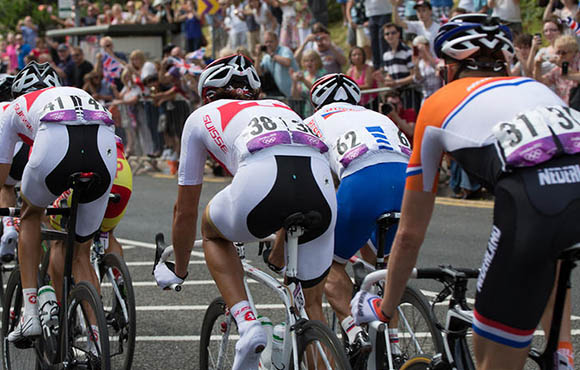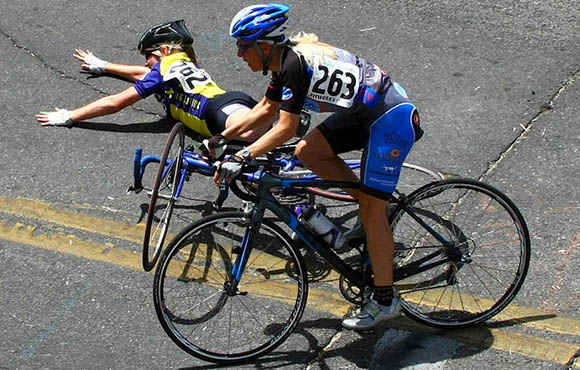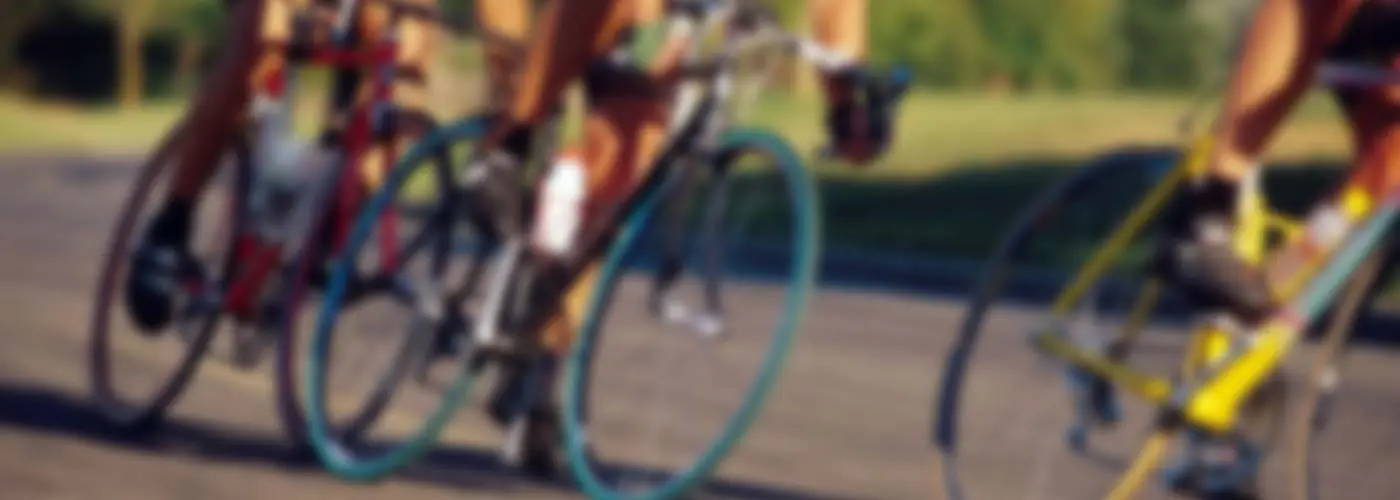But a blunder on the bike doesn't have to destroy the ride. We tapped Tara Parsons, USAC-certified coach and head of rider development for the Century Road Club Association, and Colby Pearce, a USAC-certified Level 1 coach and former professional cyclist, for expert no-sweat tips on how to survive the most common dangers of group riding. (And make sure to dial in your riding with the Bicycling Complete Book of Road Cycling Skills!)
View the original article on Bicycling.com.
Bumping Shoulders
1 of 8
Nope, this isn't the latest rap-inspired dance move. When another cyclist gets too close, your shoulders or elbows might brush or bump. This is common when you're riding two-by-two in a large group, in a race when people are trying to position, or during a tight turn.
To avoid letting a little bump on the road ruin the ride, keep your elbows bent and tucked in.
"One of the most common things I see is people using their elbows to guard their space," Parsons says. "Someone hitting your elbow could push your front wheel over, and you'll crash."
If you bump shoulders, lean into it.
"Pushing your shoulder into theirs will push your bars away from theirs, but keep your center of gravity aligned over the bottom bracket—and keep you upright," Pearce adds.
His tip: Prep for this scenario by simply grabbing a buddy and actually trying it. Find a grassy field, and start off by riding really close. Then touch elbows, then bump shoulders, then lean in to push your bars away, and pop them off.
"Once you actually do it a few times, when it happens in a group, it's really no big deal," he says. So go on and bump your shoulders off.
Find:
Your Next RideTouching Tires
2 of 8
The rule on group rides is to keep your tires to yourself. But if your front wheel is feeling frisky, it might graze the rear wheel of the person in front of you.
This can happen head-on or on one side when wheels overlap and the tires' sidewalls brush. The most common culprit? When someone stands up in front of you on a climb, and their bike shoots back half a bike length.
If you find your tires getting friendly with another's, do the exact opposite of what you think you should do.
"This is absolutely counterintuitive, but you want to steer into their wheel and slow your speed to let them ride away," Parsons says. Because the rear wheel holds most of the weight, it's more stable, so the person in front of you will be totally fine. Heck, they might not even realize it happened! But because your front wheel is less stable, you need to steer into their wheel to smoothly push your bike away to safety.
Find:
Your Next RideRiding Out a Flat
3 of 8
Flats happen. Fortunately, most happen in a situation where you can ride them out safely—you nail a pothole, roll over some glass, whatever. But this becomes trickier when you're sandwiched in the middle of a group.
First, don't slam on your brakes, but do communicate the flat to the rest of the group immediately.
"The universal signal for a flat is to put one hand up,'" Pearce says.
He recommends shifting most of your weight onto the wheel with air, and slowing your speed to start to move out of the group and off to the side for safety. "The most important thing is to keep your bike in control, upright, and straight," he says. Turning or leaning your bike on a flat tire is no bueno.
If you're not comfortable taking your hands off the bars (especially if you have a front flat) or you suspect the signal is not totally universal for the group, just yell "Flat!"
"Now's not the time to worry about being obnoxious; apologies are easier when everyone has their skin," Pearce says. "The group would rather hear you scream than end up on the ground."
The sneakiest—and therefore sketchiest—kind of flat is when your tire is gradually losing air, you don't realize it, and then you wash out. So be sure to look out for others in the group and alert them if their tire looks low.
Find:
Your Next RideAvoiding Another Cyclist's Mechanical
4 of 8
In a group of good cyclists (see: pro peloton), a mechanical in the pack will look like Moses parting the seas. The issue is communicated, and the group smoothly sails around it before coming back together. But in a group ride, this could look like a 15-car pile-up if you're not careful.
We can't predict exactly what's going to go down, but no matter the situation, it's your job to look for the open space.
"Don't slam on your brakes, try to keep moving forward if possible, and look for the opening to keep the group safe," Parsons says.
If you have to move off onto uneven surface like gravel or a chopped road shoulder, just keep pedaling to maintain traction.
Most importantly, don't rubberneck.
"I find that riders will stare at what's happening, and that's a surefire way to end up in the middle of what's happening," she says. "Your bike will follow your gaze so train yourself to look for the space that's open. Don't look at the thing you don't want to hit."
Find:
Your Next RideDrafting an Unpredictable Rider
5 of 8
If you ride on enough group rides, you're bound to encounter someone whose group skills aren't exactly dialed. An unpredictable rider might be squirrely, visibly uncomfortable signaling, unable to hold their line, overly cautious, overly confident—the scenarios are endless.
There's not a whole lot you can do other than give them extra space. "Don't sit on their wheel within six inches," Parsons says. "Give them half a bike length or a wheel length at least." This will give you enough space and time to adjust to their riding style.
The other option: Improve your group riding skills to make sure you're smooth, and lead by example. "Relax your upper body, bend your elbows so movement in your torso doesn't transfer through your front wheel, make sure you're pedaling at an even cadence, and practice feathering your brakes to modulate your speed," Parsons says.
Find:
Your Next RideA Surging Pace
6 of 8
Turns out, yo-yoing was only cool in the '90s. In a rotating paceline, when the people in front peel off, the cyclists behind know it's going to be a harder effort in the wind, and people don't want to disappoint the group, so they ramp up the effort so much that suddenly the pace picks up. When the pace surges, it strings out the group and leads to a "yo-yo" effect, making it difficult for everyone to ride smoothly. Not cool.
When you're in a rotating paceline, focus on how fast you're turning over the pedals. "Watch or listen to your cadence, not your power or speed," Pearce says. "When you hit the wind, your power will go up, but power and perceived exertion don't always match up; you might feel like you're not lifting the pace but you are."
If there's just one inconsistent rider on the front, simply give them a heads up. They might not even realize it's happening. But if they continue to surge, you might just need to tell them to get lost.
"The person that shows up to the group ride and punishes everyone should really just go ride on their own," Pearce says. "If everyone wants the group to go as fast as they can collectively, communication is key, especially with riders of different experience and fitness levels."
Find:
Your Next RideAvoiding Unexpected Obstacles
7 of 8
On any group ride, expect the unexpected. At any moment, someone can drop a bottle—or worse, a phone—a pothole might appear out of nowhere, there's some fresh roadkill in your path. Bleh.
"The best thing you can do is give the object a little room, point at it, and call it out to make as many people aware of it as possible," Pearce says. If you're in the front, that's your job. If you're in the middle, it's your job to pass it on. "It's just like the game of telephone; it's courteous and respectful," he says.
Another trick to keep in your back pocket: Learn to bunny hop.
"It's not the best thing to do on a group ride, but it's definitely one of those skills that's important to be able to pull out just in case," Parsons says. She teaches cyclist the proper way to bunny hop (ie: not jerking your bike up with your legs and just slamming it down.) Find a few objects that are non-consequence (think: a pillow or a plastic jug) and head to a parking lot to practice. "The more useful skills you have like that, the more likely you'll be able to keep the bike upright," Pearce adds.
Find:
Your Next RideAbout the Author








Discuss This Article